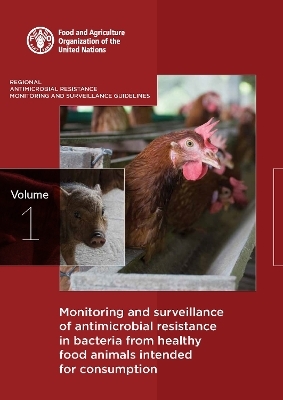
Monitoring and surveillance of antimicrobial resistance in bacteria from healthy food animals intended for consumption
Vol. 1: Regional antimicrobial resistance monitoring and surveillance guidelines
Seiten
2020
Food & Agriculture Organization of the United Nations (FAO) (Verlag)
978-92-5-131930-7 (ISBN)
Food & Agriculture Organization of the United Nations (FAO) (Verlag)
978-92-5-131930-7 (ISBN)
Provides guidance on the design of antimicrobial resistance (AMR) monitoring and surveillance, on relevant epidemiology and laboratory methods, as well as AMR data management. This manual is applicable to major food animal species including broilers, swine, cattle and their meat products.
This publication provides guidance on the design of antimicrobial resistance (AMR) monitoring and surveillance, on relevant epidemiology and laboratory methods, as well as AMR data management. It underscores the importance of samples from apparently healthy animals and food products of animal origin so as to reflect an unbiased estimate of the prevalence of AMR in target organisms circulating in the major animal commodities of the countries of the region. This manual is applicable to major food animal species including broilers, swine, cattle and their meat products (i.e. chicken meat, pork, beef). In this context, the selected food-borne pathogens Salmonella enterica and Campylobacter spp. (C. jejuni and C. coli) and the commensal bacteria Escherichia coli and Enterococcus spp. (E. faecium and E. faecalis) are those considered most relevant to AMR monitoring from a public health perspective. These guidelines encourage countries to initiate AMR surveillance regardless of their capacity, and provide recommended approaches to move progressively towards a regionally harmonized and standardized approach, important for comparability and for monitoring changes in the susceptibility of target bacteria to specific antimicrobials over the years to come.
This publication provides guidance on the design of antimicrobial resistance (AMR) monitoring and surveillance, on relevant epidemiology and laboratory methods, as well as AMR data management. It underscores the importance of samples from apparently healthy animals and food products of animal origin so as to reflect an unbiased estimate of the prevalence of AMR in target organisms circulating in the major animal commodities of the countries of the region. This manual is applicable to major food animal species including broilers, swine, cattle and their meat products (i.e. chicken meat, pork, beef). In this context, the selected food-borne pathogens Salmonella enterica and Campylobacter spp. (C. jejuni and C. coli) and the commensal bacteria Escherichia coli and Enterococcus spp. (E. faecium and E. faecalis) are those considered most relevant to AMR monitoring from a public health perspective. These guidelines encourage countries to initiate AMR surveillance regardless of their capacity, and provide recommended approaches to move progressively towards a regionally harmonized and standardized approach, important for comparability and for monitoring changes in the susceptibility of target bacteria to specific antimicrobials over the years to come.
| Erscheinungsdatum | 03.01.2020 |
|---|---|
| Reihe/Serie | Monitoring and surveillance of antimicrobial resistance in bacteria from healthy food animals intended for consumption |
| Verlagsort | Rome |
| Sprache | englisch |
| Themenwelt | Technik ► Lebensmitteltechnologie |
| Veterinärmedizin ► Großtier | |
| Weitere Fachgebiete ► Land- / Forstwirtschaft / Fischerei | |
| ISBN-10 | 92-5-131930-8 / 9251319308 |
| ISBN-13 | 978-92-5-131930-7 / 9789251319307 |
| Zustand | Neuware |
| Haben Sie eine Frage zum Produkt? |
Mehr entdecken
aus dem Bereich
aus dem Bereich
Technologie, Chemie, Mikrobiologie, Analytik, Bedeutung, Recht
Buch | Hardcover (2023)
Verlag Eugen Ulmer
140,00 €


